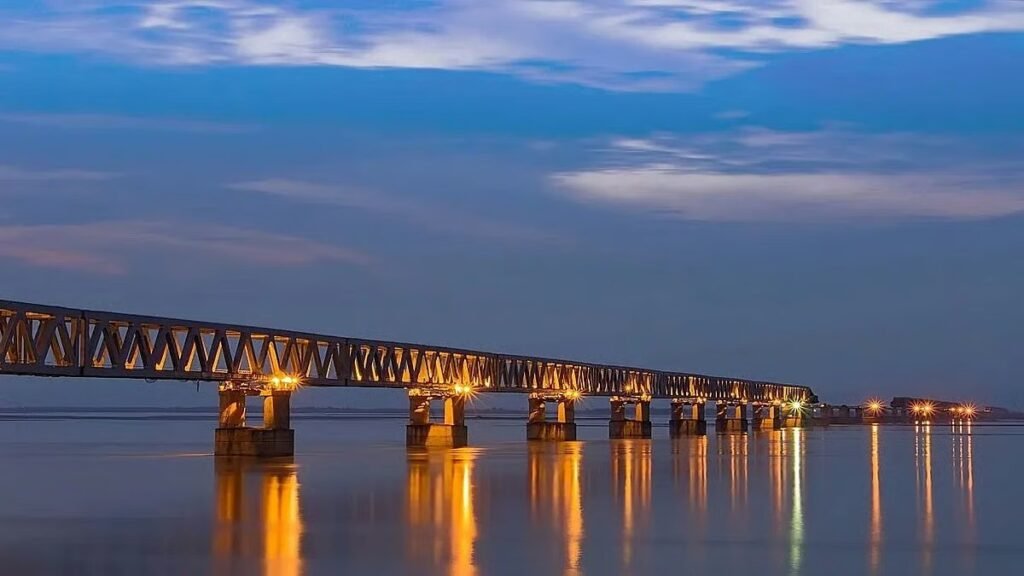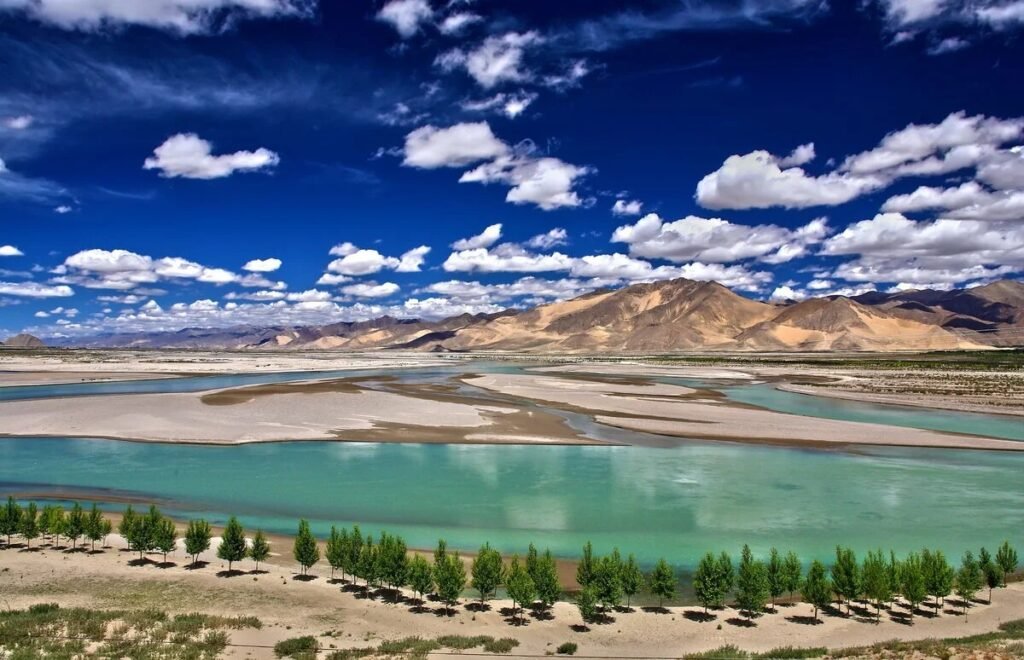The Brahmaputra River, one of Asia’s greatest waterways, has etched its story deep into the soil, culture, and economy of the regions it traverses, namely Tibet (China), India, and Bangladesh. This mighty river, with its fascinating journey from icy Himalayan origins to the fertile plains and bustling deltas, is revered not only for its physical grandeur but also for its cultural and historical resonance.
Origin and Course
The Brahmaputra River originates from the Chemayungdung (Angsi) Glacier, near Mount Kailash, at an elevation of about 5,150 meters in Tibet, where it is called the Yarlung Tsangpo. The river flows eastward, covering over 1,600 km in Tibet before entering India at Arunachal Pradesh. There, it becomes the Siang and then the Brahmaputra after meeting its tributaries like the Dibang and the Lohit. As it journeys through Assam, the river spreads across wide floodplains, nurturing millions. It eventually passes into Bangladesh as the Jamuna, merging with the Ganga to form the largest river delta on Earth, the Sundarbans.
Places and Route
States and Cities
The Brahmaputra River flows through several Indian states and major cities:
- Arunachal Pradesh, Assam, Meghalaya, Nagaland, Sikkim, West Bengal
- Key cities: Dibrugarh, Pasighat, Neamati, Tezpur, Guwahati (main urban hub)
Tourist Spots
- Kaziranga National Park: A UNESCO World Heritage site, famous for the one-horned rhinoceros.
- Majuli Island: The world’s largest inhabited river island, renowned for Vaishnavite culture.
- Kamakhya Temple: A major Hindu pilgrimage centre offering panoramic river views from atop Nilachal Hill.
- Deepor Beel Wildlife Sanctuary: An important biodiversity hotspot for birdwatchers and nature enthusiasts.
- River Cruises: Luxury cruises offer intimate experiences along the banks, stopping at cultural and natural landmarks.
Route Summary
- Origin: Chemayungdung Glacier (Tibet)
- Names along route: Yarlung Tsangpo (Tibet), Siang (Arunachal Pradesh), Brahmaputra (Assam), Jamuna (Bangladesh)
- Merges with: Ganga (Padma in Bangladesh); becomes Meghna, finally entering the Bay of Bengal
Key Details:
- Brahmaputra River cruises with wildlife excursions, cultural events, and tea garden visits are most popular between November and April, as these months offer a comfortable climate and the best visibility.
- Standard sunset or lunch/dinner cruises in Guwahati cost around INR 350–1,200 per person, while longer luxury cruise packages range from INR 4,800–6,100 per person depending on duration, amenities, and season.
- Majuli, the world’s largest river island and a UNESCO site, is accessible by ferry for INR 100–500 per person from Guwahati or Jorhat. It is available year-round but is best during the post-monsoon period for safety and scenic charm.
- Entry fees for Kaziranga National Park and other wildlife spots along the Brahmaputra River typically range from INR 500–2,000, depending on activities and safaris.
Historical Significance
Historically, the Brahmaputra River has shaped civilisations and narratives. In medieval Assam, its riverbanks fostered the rise of the Ahom state, with island camps, boat-building departments, and military garrisons reinforcing riverine power. Its strategic location often determined the fate of kings and empires, including defence strategies and communication during invasions. Over centuries, the course of the Brahmaputra River has shifted dramatically, altering landscapes and livelihoods with sudden floods and avulsions, as noted in historical records dating back to the 18th century.
Cultural Importance
The Brahmaputra River is deeply entwined with culture. It’s celebrated during Assam’s Bihu festival, a joyous agricultural and New Year celebration in reverence of the river’s bounty and blessing. Majuli, the world’s largest river island situated on the Brahmaputra, is home to Vaishnavite monasteries (Satras) and unique traditions of music, dance, and crafts. Unlike most rivers in India, the Brahmaputra is mythologically considered masculine and embodies fierce dynamism, inspiring folklore about Lord Brahma and divine masculinity. The river’s role in shaping language, ritual, and even vocabulary through the colonial steamboat trade remains notable.
Economic Impact and Revenue
The Brahmaputra’s fertile floodplains are a bedrock for Assam’s agriculture, sustaining vital crops like rice, tea, and jute, along with a prosperous fishing industry. The river is a crucial trade route, facilitating the movement of goods, and supports tourism, eco-tourism, and cultural exchanges. Major hydropower potentials (over 66,000 MW) underpin regional development, with projects like Subansiri, Ranganadi, Dibang, and Lower Subansiri boosting energy security. Infrastructure, such as the Dhola-Sadiya Bridge, has improved connectivity across Assam, driving revenue and linkage between remote and urban centres.
Biodiversity and Environment
The Brahmaputra River’s vast floodplains and islands harbour crucial wildlife, including endangered species like the Gangetic river dolphin and one-horned rhinoceros. National parks such as Kaziranga and Manas are situated on the banks of the Brahmaputra River, protecting ecosystems that support both terrestrial and aquatic life. Flood cycles create fertile soils but also present risks of inundation and erosion, necessitating careful environmental management.
Cultural Celebrations, Legends, and Beliefs
- Bihu Festival: Celebrated in April, marking the agricultural New Year with dances, music, and gratitude for the river’s bounty.
- Majuli Island Festivals: Spiritual and cultural events hosted at Satras feature music, crafts, and folk performances.
- Ambubachi Mela: Annual festival at Kamakhya Temple attracts pilgrims celebrating fertility and divine blessings connected to the river.
- Legends: Mythical stories highlight Brahmaputra’s divine origin from Lord Brahma, symbolising power and dynamism.

Modern Development and Challenges
Hydropower and Infrastructure
Numerous hydropower projects harness the Brahmaputra’s kinetic energy, including Tawang, Subansiri, Ranganadi, and Kameng, with ongoing expansion. Bridges such as Dhola-Sadiya have revolutionised connectivity, linking people, goods, and services.
Floods and Environmental Risks
Annual floods, while crucial for soil fertility, can be devastating, impacting lives, agriculture, and even renowned parks like Kaziranga. Ongoing projects focus on flood management, river channel stabilisation, and sustainable tourism to balance development and ecology.
Recent News
In 2025, as river tourism flourishes and hydropower projects accelerate, the Brahmaputra River faces both fresh opportunities and mounting challenges, from climate risks to cultural preservation. Assam’s riverfronts welcome global visitors, Majuli’s heritage thrives, and new infrastructure strengthens ties across the region, yet stakeholders must harmonise growth with environmental stewardship to safeguard the river’s legacy for future generations.
FAQs on Brahmaputra River
Where does the Brahmaputra River originate?
The Brahmaputra River originates at the Chemayungdung Glacier near Mount Kailash in Tibet, at an elevation of over 5,000 meters.
Why is the Brahmaputra considered masculine in Indian mythology?
Unlike most rivers, the Brahmaputra is mythologically masculine, symbolising strength and dynamism, believed to be the “son of Brahma”.
What is Majuli, and why is it important?
Majuli is the largest river island in the world, located in Assam. It’s a UNESCO-recognised heritage site, home to unique spiritual traditions and vibrant Vaishnavite monasteries.
How does the Brahmaputra impact Assam’s economy?
The river supports agriculture, fisheries, trade routes, hydropower, and burgeoning tourism, making it a backbone of Assam’s economy and livelihoods.
Which places are best for tourism near the Brahmaputra River?
Top spots include Kaziranga National Park, Majuli Island, Kamakhya Temple, Deepor Beel Wildlife Sanctuary, and luxury cruises along the river.
What are the main challenges posed by the Brahmaputra?
Annual floods, riverbank erosion, and environmental concerns: while floods regenerate soils, they often devastate infrastructure and wildlife.
What are the major tributaries of the Brahmaputra?
Important tributaries include Dibang, Lohit, Subansiri, and Dhansiri, supplying the Brahmaputra as it moves towards Assam.
What hydropower projects are found on the Brahmaputra?
Key projects include Subansiri, Ranganadi, Dibang, Kameng (Arunachal Pradesh), Doyang (Nagaland), and Loktak (Manipur).
How does the Brahmaputra bridge cultures?
With centuries of trade, festivals, agricultural cycles, and mythologies, the Brahmaputra River connects communities across South Asia, blending traditions and languages through its influence.
